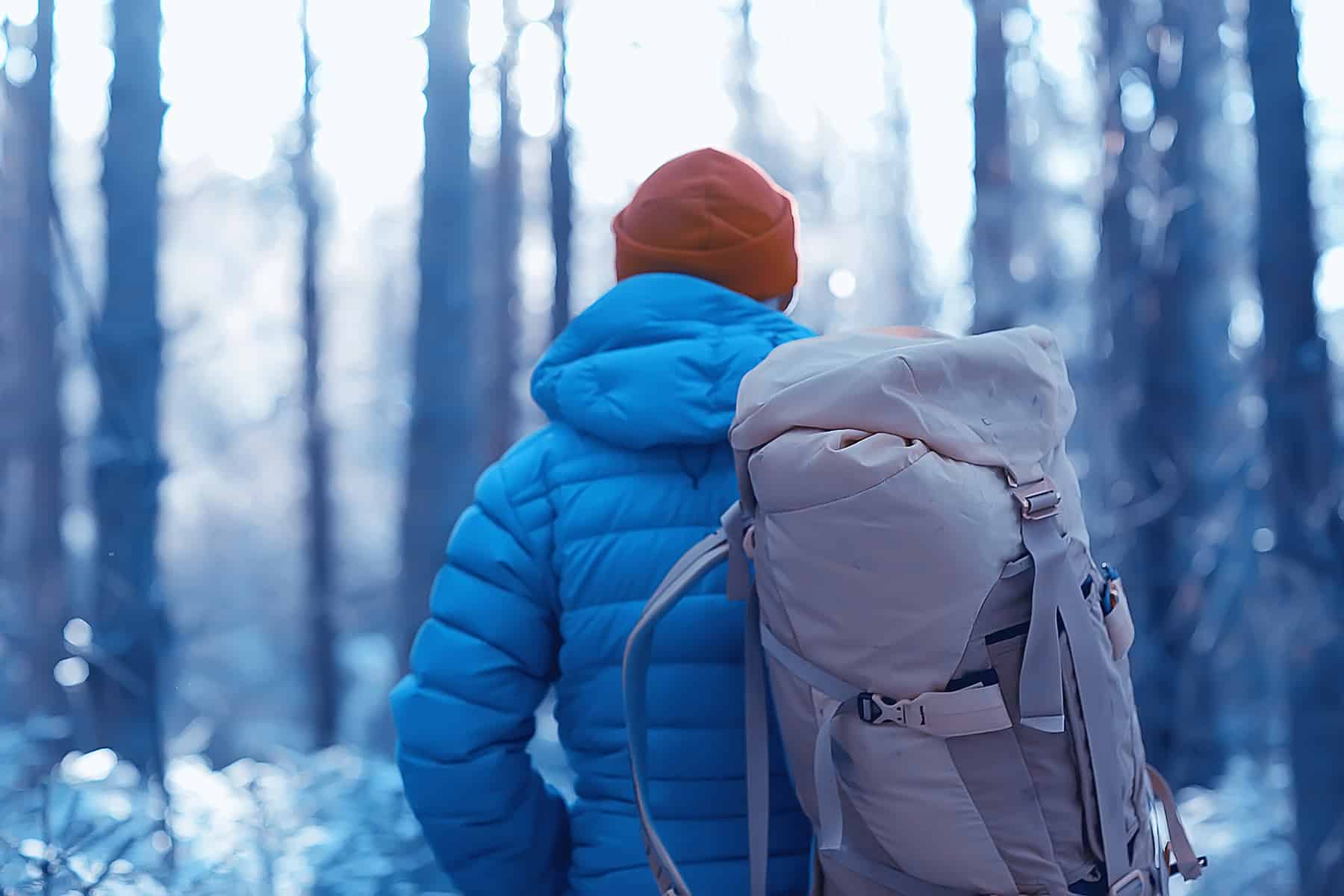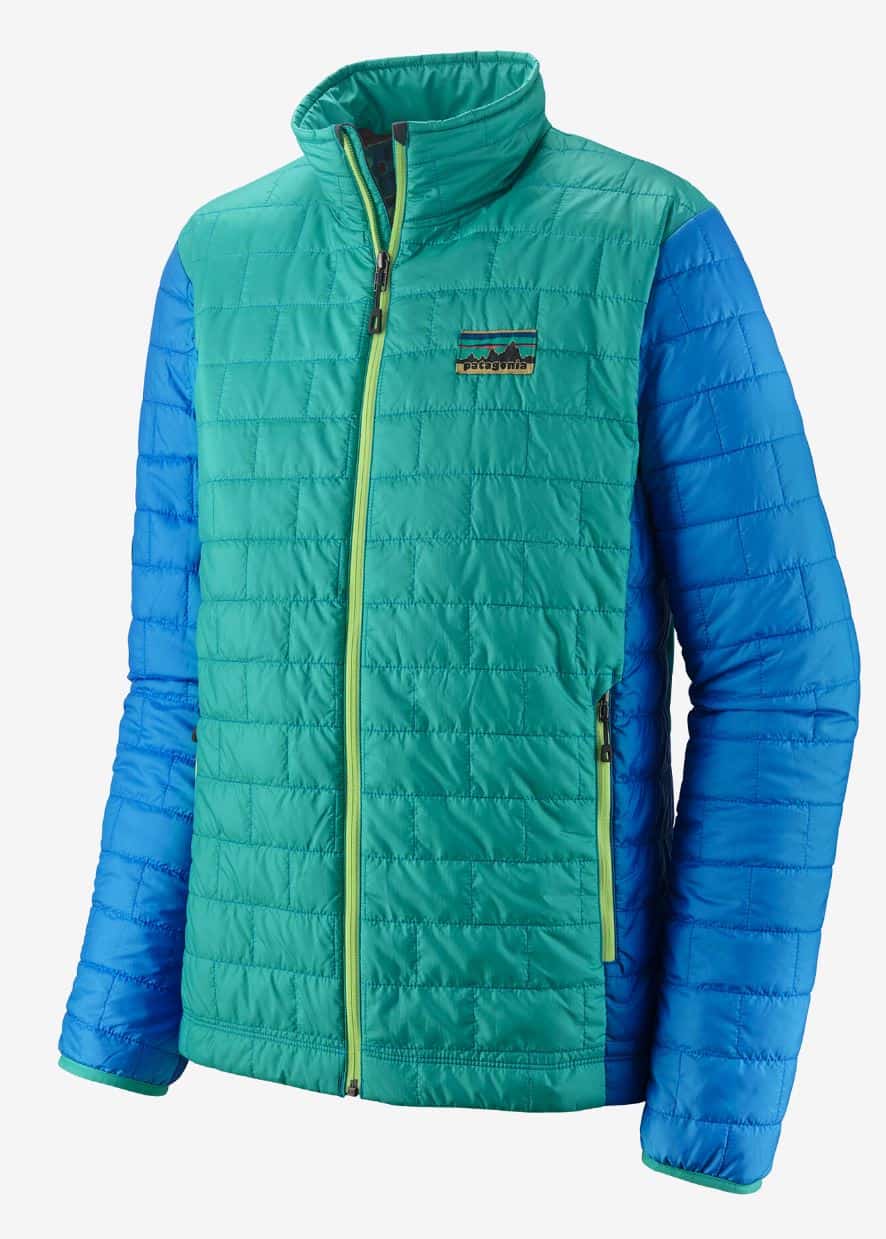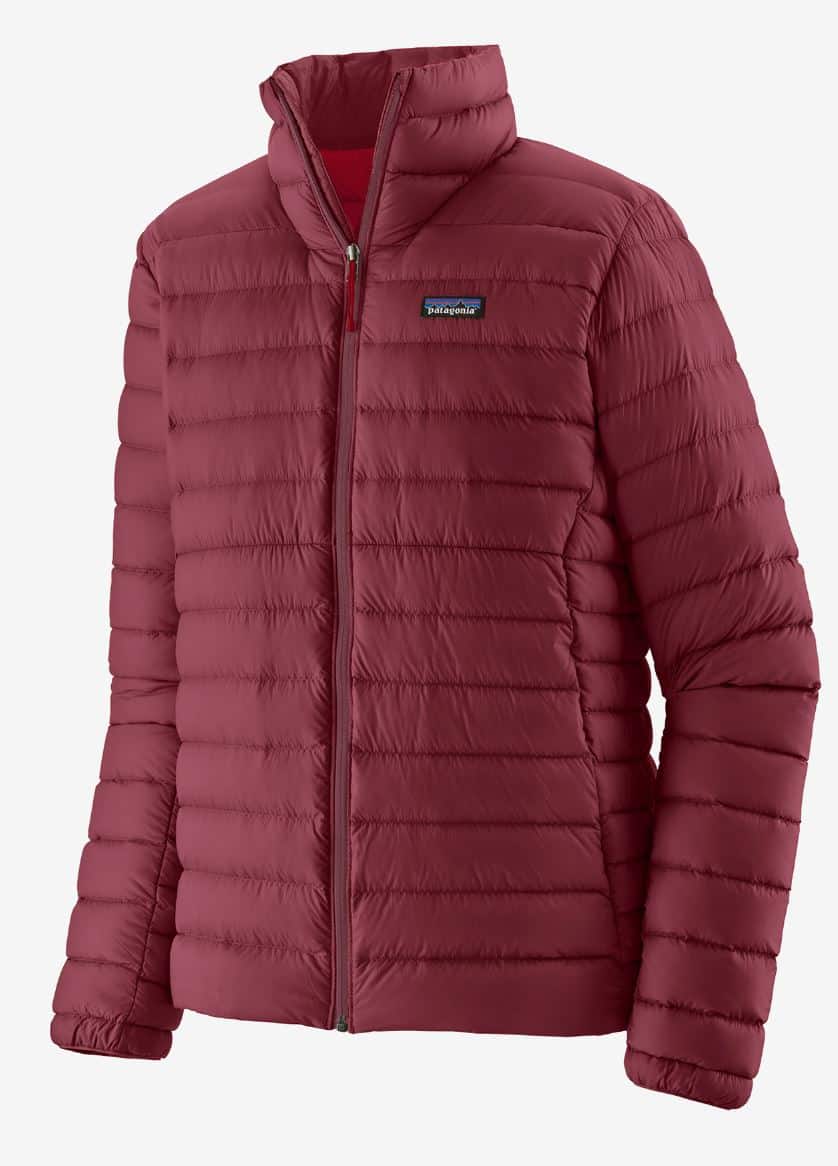If you want an everyday jacket for warm winters, or if you want to layer up in icy temperatures, a lightweight puffer is a way to go. When it comes to warm lightweight jackets, Patagonia is one of the top brands on the market.
But there are many lightweight Patagonia jackets you can choose from, so you may have a hard time finding the best model for you. This Patagonia Nano Puff vs Down Sweater comparison aims to make it easier for you.
The Nano Puff is one of the brand’s flagship synthetic down jackets while the Patagonia Down Sweater is one of the most popular lightweight down puffers.
While the difference between insulation materials dominates this Patagonia Nano Puff vs Down Sweater comparison, there’s much more to it.
Patagonia Nano Puff
Specs:
- Weight: 11.9 oz
- Shell and lining: 100% recycled polyester ripstop fabric
- Insulation material: 60g PrimaLoft Gold Insulation Eco
- Hood: Optional
- Packable: Yes
Ever since it was introduced to the market in 2010, the Nano Puff jacket has been one of the most popular Patagonia products. Outdoor gear lovers fell in love with this puffer primarily because of its versatility. Patagonia comes with a newer model Micro Puff which is basically the new Nano Puff but brings the latest technology. Read our detailed comparison of Nano Puff vs Micro Puff to get to know more.
There are very few warm but lightweight synthetic materials that can come close to Nano Puff’s PrimaLoft insulation.
This puffer makes for a great outer layer for winter activities. However, the shoulders and the underarms may feel a bit tight if you don’t get the size right. If you plan to wear a thick base layer underneath, you may want to size up.
The jacket sports key weatherproof properties and roomy zippered pockets. The internal chest pocket is big enough for a buff, hat, or a small hydration bladder. It even doubles as the jacket’s self stuffing sack.
The cinch at the hem and the elastic cuffs do a great job of sealing out the cold. You can count on the solid liner and the face fabric to block out the wind. The jacket also features a DWR (durable water repellent) finish that beads water quite well.
Like most Patagonia Jackets, this puffer is just as stylish as it is functional. If you would like to get a hooded version of the jacket, check out the Patagonia Nano Puff Hoody. It offers even better protection from the elements.
PROS:
- Great value
- Lightweight
- Small packed size
- Versatile
- Water-resistant
CONS:
- Shoulders and underarms may feel too tight
Patagonia Down Sweater
Specs:
- Weight: 13.1 oz
- Shell and lining: 100% recycled polyester ripstop fabric
- Insulation material: 800-fill power goose down
- Hood: Optional
- Packable: Yes
If you are looking for a tried and true classic down puffer, the Patagonia Down Sweater is a solid option.
The jacket has a comfortable fit and features high-quality European goose down, so it makes for a great mid-layer for winter activities. Since it is compressible and lightweight, it’s also a great option for cold summer adventures in the mountains.
The Patagonia Down Sweater is snug, but it allows for great freedom of movement at the same time. The elastic cuffs feel nice, and the hem drawcord is recessed into the two handwarmer pockets.
This puffer is designed to be functional and durable above everything else. However, its stylish look is also worth mentioning.
The shell and the lining are fairly weather-resistant. The DWR treatment does a great job of shedding light rain and snow. It won’t hold up for very long in a full-blown storm, but it will keep the insulation dry long enough for you to find shelter.
If you would like to buy a hooded version of this jacket, take a look at the Patagonia Down Sweater Hoody.
PROS:
- Stylish
- High-quality goose down
- Versatile
- Durable
- Allows for great freedom of movement
CONS:
- Pricey
Patagonia Nano Puff vs Down Sweater: Similarities and Differences
Insulation
When you are buying a jacket for cold weather, insulation is the most important thing to consider. A winter jacket can feature either synthetic down or natural down. Each type of insulation has its pros and cons.
The Patagonia Down Sweater features 800-fill-power goose down. All the down that the company uses is certified by the Advanced Global Traceable Standard. It guarantees that the down is sustainably and ethically sourced.
Generally, natural down insulates better than synthetic down. Goose down is the warmest type of down. Even when compressed, it retains its shape and loft. Goose down is lighter and more breathable than duck down.
However, down insulation has a significant drawback. It loses its insulating properties when it gets wet. To be able to keep you warm in rainy weather, Patagonia’s down puffer uses a water-resistant outer shell.
But the DWR treatment can’t hold up forever, no matter how good it is. If the jacket is exposed to rain for too long, the water will eventually penetrate the outer layer and the jacket will consequently lose its warmth.
Synthetic insulation, on the other hand, will keep you warm even if it gets wet. So, Patagonia’s synthetic puffer is undoubtedly a better jacket for wet climates. However, if you plan hiking only in rainy weather you should consider wearing a lightweight rain jacket.
The Patagonia Nano Puff jacket uses two ounces of PrimaLoft Gold Insulation Eco. PrimaLoft makes the best synthetic insulation on the market, and almost all high-end outdoor brands use its products. Gold Insulation Eco is as warm as 550-fill-power down.
Each jacket has a drop tail hem and elasticized cuffs that seal out the cold air. Even though the Down Sweater has a slightly better warmth-to-weight ratio, both jackets are more than warm enough for moderately cold weather and low to mid-altitude alpine climbing or ski touring.
Weight and Packability
The Nano Puff weighs a bit less than the Down Sweater, despite using a heavier insulation material.
While the difference in weight doesn’t seem to be too big, every ounce counts when you are on a multi-day backpacking adventure. This consideration is even more important if you plan on stashing your jacket in your hiking backpack.
Each jacket stuffs tightly into its chest pocket. Compared to the Down Sweater, the Nano Puff packs down to a smaller size. In fact, it is one of the best jackets on the market when it comes to packed size.
It takes more time and effort to pack the Nano Puff than it takes to pack the Down Sweater. But you need to make sure the Down Sweater is completely dry before you stuff it into its chest pocket.
If you pack the jacket when it is wet, the insulation material may get damaged. Moreover, the down will lose some of its lofts if it stays packed for too long.
When it comes to minimalist backpacking, Patagonia’s synthetic down jacket is the winner of the Down Sweater vs Nano Puff comparison.
Durability
Patagonia is renowned for the durability and quality of its products. When it comes to the quality of the quilted-through construction, the two jackets are almost the same.
But if you are looking for a jacket for rough use, you’ll be better off with the Down Sweater. The reason is pretty straightforward—The Down Sweater shell is 30-denier polyester while the Nano Puff shell is only 22-denier polyester. The higher the denier, the tougher the fabric.
You can expect the Down Sweater to be more abrasion-resistant than the Nano Puff. Moreover, the older versions of the Nano Puff jacket don’t use ripstop fabrics. So, if you want to purchase this puffer, make sure to check the label first.
When it comes to durability, Patagonia’s down puffer is the winner of the Down Sweater vs Nano Puff showdown.
Features
The two jackets share similar, minimalist features. The Nano Puff comes with two zippered hand pockets and a zippered chest pocket. The deep pockets will keep your hands warm on chilly days.
All of the pockets feature easy-to-grab pulls. To protect your stuff from getting wet, the zipper garages hold them in place.
The pockets on the Down Sweater are practically the same. Moreover, each jacket has a zipper garage at the chin and a wicking interior storm flap.
The biggest difference here is the fact that the two jackets use different zippers. The down jacket features Vilson zippers while the other one has coil zippers.
Vilson zippers are made from extremely durable Delrin plastic. They aren’t as flexible as coil zippers, but they offer better protection against the weather.
Both puffers feature elasticized cuffs that are designed to keep out the cold. However, the cuffs on the down jacket feel snugger.
The Nano Puff has an adjustable hem, and so does the Down Sweater. But the Down Sweater has better hem drawcords.
They are located in the hand pockets, so you can adjust the hem without having to get your hands out of the pockets. Since the Nano Puff has a hem cinch on the outside of the jacket, you have to make an effort to keep it out of the way of your gear.
If you would like to get a jacket with more functional features, the Down Sweater is the better choice.
Fit and Comfort
The Nano Puff has a regular fit. It offers a decent amount of mobility. However, as mentioned, some shoppers have complained that the underarms and the shoulders are too tight. This can be a problem if you want to double up base layers without trying out the jacket first.
The Down Sweater has a spot-on fit. It isn’t loose or bulky. You can comfortably wear it under an outer layer or over a thick base layer. Undoubtedly, the Down Sweater is true to size.
In terms of comfort, neither of these coats scores high. Both the Down Sweater and the Nano Puff jacket are designed to be functional and lightweight.
They feature slippery fabrics that allow them to layer well. The problem is that these same fabrics can feel uncomfortable when you are sweating a lot.
Weather-Resistance and Breathability
Neither the Nano Puff jacket nor the Down Sweater is fully waterproof. However, both puffers are able to resist rain and wind more than well.
Both the Patagonia Nano Puff and the Down Sweater do a great job of shedding light rain. They feature a similar DWR coating.
No matter which jacket you choose, do know that DWR won’t hold forever. The more often you wear a jacket in wet weather, the sooner you will need to reapply the DWR coating. That being said, you can expect Patagonia’s DWR coating to last quite a long time.
Even though both puffers use almost the same DWR treatment, the Nano Puff doesn’t hold up against rain as well as the Down Sweater does.
Unlike the Down Sweater, the Nano Puff has tons of stitching sewn through it. If you wear a DWR-treated jacket in heavy rainfall for too long, the stitching will be the first to get saturated.
Moreover, a particularly strong wind can cut through the outer layer at the site of the stitching. While it still does a great job at functioning as a windbreaker, the Down Sweater is a slightly better choice for threatening weather.
The Nano Puff jacket is more breathable than the down puffer. Since the insulating material isn’t super-stacked, the air can easily move in and out.
Warranty
As far as warranty policies go, Patagonia may indeed be the best outdoor brand on the market. The brand backs every jacket it makes with its Ironclad Guarantee.
It covers defects in the materials and workmanship for life. Moreover, you can return your jacket to Patagonia for any reason whatsoever.
The Ironclad Guarantee doesn’t cover normal wear and tear. But Patagonia will repair any damage for a nominal fee. The brand will go out of its way to extend the lifespan of its products.
Patagonia Nano Puff vs Down Sweater: Which Jacket Is Better?
The Patagonia Nano Puff vs Down Sweater showdown has no clear-cut winner. Patagonia’s down jacket is a better option when it comes to durability, weather resistance, and warmth, but not by a long shot.
If you are a minimalist backpacker, the Nano Puff may be the best option for you. It is lightweight and packs down to an impressively small size, but doesn’t lag far behind Patagonia’s down puffer in terms of performance. Both models are some of the best down jackets on the market.

I love hiking, backpacking, and camping. From the Camino de Santiago to the West Highland Way in Scotland or simply a great day hike on the weekend. Hiking refreshes me, my mind, and keeps my body reasonably fit. So far I have walked three Camino routes and many other long distance hikes in the UK, Canada, and around the rest of Europe. One of the best was my hike up Ben Nevis.



